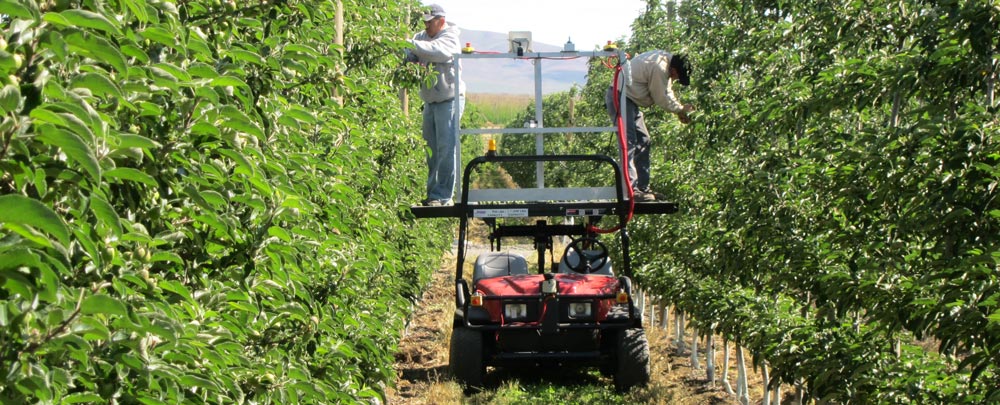Autonomous Orchard Vehicles
To address the need to increase efficiency and reduce labor costs of tree fruit production, we are developing autonomous orchard vehicles to augment and automate tasks such as pruning, thinning, tree training, harvesting, mowing, and spraying. To date, industry has focused on implements that can be attached to tractors, most of which have been designed for tasks that require significant power. Today, the need is for a generation of nimble, low-cost vehicles that can be easily reconfigured for tasks that require precision rather than brawn. Such vehicles will used year-round, be up to date with standards in information technology and will fit into the electronic workflow management of crops.

Results
The four vehicles developed in the four years of CASC have together completed over 350 km of autonomous driving in research and commercial orchards and nurseries in Washington, Pennsylvania, Maryland, Ohio, and New York. Two of them, Cascade and Allegheny, are used by the Extension teams at Washington State and Penn State to conduct time trials in orchards near Prosser, WA, and Biglerville, PA. They are equipped with a platform where workers stand safely while conducting work on the upper parts of the trees. With this autonomous platform capability, workers no longer have to climb and move ladders, which are known to be inefficient and injury-prone. With the vehicle creeping slowly underneath them, the workers no longer have to go to the trees; rather, the trees "come to them." Trial results indicate that workers on the platform can be twice as fast when completing certain tasks on the upper part of trees as workers using ladders. The other two vehicles, Tuscarora and Laurel, are located at Carnegie Mellon. They are used to test new sensing, perception, planning, and control algorithms before integration in Cascade and Allegheny. Recently, Tuscarora was used to demonstrate full-block mowing and as a "bin dog" aid to apple color picking.
As part of our work in autonomous orchard vehicles and platforms, we also developed methods and algorithms to locate the vehicle in the orchard to within half a meter without the use of expensive GPS receivers. This is important not only because it enables low-cost precision agriculture in tree fruit production, it also enhances the accuracy of autonomous driving. There are two versions of the localization system. One uses only the sensors used for driving to create a local map of the block, i.e., a map relative to a point on the block itself but not georeferenced to latitude and longitude. This first method is useful in applications that benefit from "on-line" position information, such as row following, and adds zero hardware cost to the vehicle. The second uses a low-cost GPS receiver to generate georeferenced, sub-meter accuracy of where the vehicle has been, albeit with a delay of 24 hours. This method is useful in precision agriculture applications that don't require real-time position information. The image below shows an example of the local map of an apple block at Ridgetop Orchards in Fishertown, PA.

